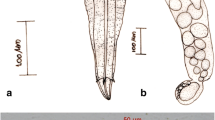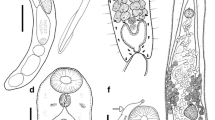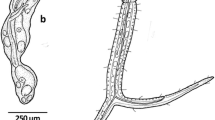Abstract
Two cercariae, one of them ocellate and with well developed tail (Monorchiidae) and another apharyngeate brevifurcocercous (Aporocotylidae), parasite of Amiantis purpurata (Lamarck, 1818) (Bivalvia, Veneridae) from the Patagonian coast on the Southwestern Atlantic Ocean, are described. These reports comprise the second monorchiid intramolluscan infection reported for the Southern Hemisphere and first intramolluscan aporocotylid for the Southern Hemisphere. In addition, this constitutes the first report of aporocotylid intramolluscan stages (parthenita) occupying only the haemocoel of the gills of a marine molluscan host rather than the digestive gland and gonad, the usual site of infection.
Similar content being viewed by others
References
Bartoli P. 1966. Contribution á l’étude des stades larvaires des trématodes marins du littoral des Bouches-du-Rhône (France): Cercaria longicaudata n. sp. (Monorchiidae). Annales de Parasitologie Humaine et Comparée, 41, 301–306.
Baudoin M. 1975. Host castration as a parasitic strategy. Evolution, 29, 335–352. DOI: 10.2307/2407221.
Bott N.J., Cribb T.H. 2005. First report of intramolluscan stages of a gorgoderid digenean from a marine bivalve. Journal of Parasitology, 91, 838–842. DOI: 10.1645/GE-449R.1.
Bullard S..A., Jensen K., Overstreet R.M. 2009. Historical account of the two family-group names in use for the single accepted family comprising the “fish blood flukes”. Acta Parasitologica, 54, 78–84. DOI: 10.2478/s11686-009-0012-8.
Cable R.M. 1956. Marine cercariae of Puerto Rico. Scientific Survey of Puerto Rico and the Virgin Islands, 16, 491–577.
Cable R.M. 1963. Marine cercariae from Curaçao and Jamaica. Zeitschrift für Parasitenkunde, 23, 429–469.
Castellanos Ageitos de Z.J. 1967. Cátalogo de los moluscos marinos bonaerenses. Anales de la Comisión de Investigaciones CientÍficas de la Provincia de Buenos Aires, 8, 1–365.
Cremonte F. (in press). Enfermedades de moluscos bivalvos de interés comercial causadas por metazoos. In: (Eds. Figueras A. and Villalba A.) Enfermedades de moluscos bivalvos de interés en Acuicultura. Observatorio Español de Acuicultura, España.
Cremonte F., Kroeck M.A., Martorelli S.R. 2001. A new monorchiid (Digenea) cercaria parasitizing the purple clam Amiantis purpurata (Veneridae) from the Southwest Atlantic Ocean, with notes on its gonadal effect. Folia Parasitologica, 48, 217–223.
Cribb T.H., Bray R.A., Olson P.D., Littlewood D.T. 2003. Life cycle evolution in the Digenea: a new perspective from phylogeny. Advances in Parasitology, 54, 197–254. DOI: 10.1016/S00 65-308X(03)54004-0.
Dobson A.P. 1988. The population biology of parasite-induced changes in host behaviour. Quarterly Review of Biology, 63, 139–165. DOI: 10.1086/415837.
Fraser T.H. 1967. Contributions to the biology of Tagelus divisus (Tellinacea: Pelecypoda) in Biscayne (Florida). Bulletin of Marine Science, 17, 111–132.
Galaktionov K.V., Dobrovolskij A.A. 2003. The biology and evolution of trematodes. An essay on the biology, morphology, life cycles, transmissions, and evolution of digenetic trematodes. Kluwer Academic Publishers, Dordrecht, The Netherlands, 592 pp.
Ginetsinskaya T.A. 1988. Trematodes, their life cycles, biology and evolution. Amerind Publishing Co. PVT. LTD, 559 pp.
Holliman R.B. 1961. Larval trematodes from Apalachee Bay area, Florida, with a checklist of known marine cercariae arranged in a key to their superfamilies. Tulane Studies in Zoology, 9, 2–74.
Kohn A., Fernandes B.M.M, Cohen S.C. (Eds.). 2007. South American Trematodes Parasites of Fishes. Fundaçao Oswaldo Cruz, CNPq, Río de Janeiro, 318 pp.
Køie M. 1982. The redia, cercaria and early stages of Aporocotyle simplex Odhner, 1900 (Sanguinicolidae) — a digenetic trematode which has a polychaete annelid as the only intermediate host. Ophelia, 21, 115–145.
Kuris A.M. 1974. Trophic interaction: similarity of parasitic castrations to parasitoids. Quarterly Review of Biology, 49, 129–148. DOI: 10.1086/408018.
Lasta M.L., Ciocco N.F., Bremec C.S., Roux A.M. 1998. Moluscos bivalvos y gasterópodos. In: (Ed. Boschi E.E.) El Mar Argentino y sus Recursos Pesqueros. Vol. 2. Instituto Nacional de Investigación y Desarrollo Pesquero, Mar del Plata, Argentina, 115–142.
Lauckner G. 1983. Diseases of Mollusca: Bivalvia. In: (Ed. Kinne O.) Diseases of Marine Animals. Vol. 2. Biologische Anstalt Helgoland, Hamburg, 477–961.
Lauckner G. 1987. Ecological effects of larval trematode infestation on littoral marine invertebrate populations. International Journal for Parasitology, 17, 391–398. DOI: 10.1016/0020-7519(87)90114-7.
Linton E. 1915. Note on trematode sporocysts and cercariae in marine mollusks of the Woods Hole region. Biological Bulletin, 28, 198–209. DOI: 10.2307/1536387.
Martin W.E. 1944. Cercaria solemyae n. sp. probably a blood fluke from a marine pelecypod, Solemya velum. Journal of Parasitology, 30, 191–195. DOI: 10.2307/3272797.
Morsan E., Kroeck M. 2005. Reproductive cycle of purple clam, Amiantis purpurata (Bivalvia: Veneridae) in northern Patagonia (Argentina). Journal of Marine Biology Association of United Kingdom, 85, 1–7. DOI: 10.1017/S002531540501129Xh.
Smith J.W. 1997. The blood flukes (Digenea: Sanguinicolidae and Spirorchidae) of cold-blooded vertebrates: Part 1. A review of the literature published since 1971, and bibliography. Helminthological Abstracts, 66, 255–294.
Stunkard H.W. 1983. The marine cercariae of the Woods Hole, Massachusetts region, a review and a revision. Biological Bulletin, 164, 143–162. DOI: 10.2307/1541135.
Wardle W.J. 1979. A new marine cercaria (Digenea: Aporocotylidae) from the southern quahog Mercenaria campechiensis. Contributions in Marine Science, 22, 53–56.
Author information
Authors and Affiliations
Corresponding author
Rights and permissions
About this article
Cite this article
Gilardoni, C., Posadas, G., Kroeck, M.A. et al. Monorchiid and aporocotylid cercariae (Digenea) parasitising the purple clam Amiantis purpurata (Bivalvia, Veneridae) from the Southwestern Atlantic coast. Acta Parasit. 56, 385–391 (2011). https://doi.org/10.2478/s11686-011-0074-2
Accepted:
Published:
Issue Date:
DOI: https://doi.org/10.2478/s11686-011-0074-2




